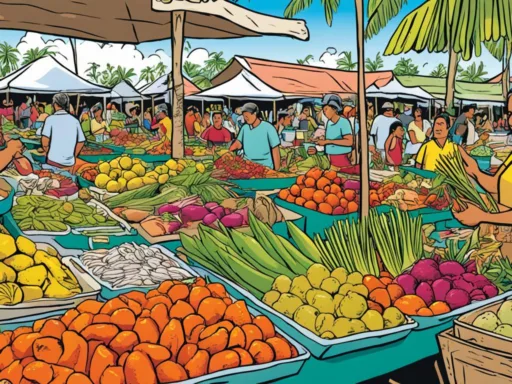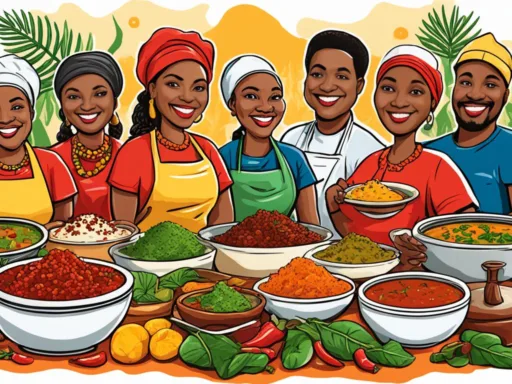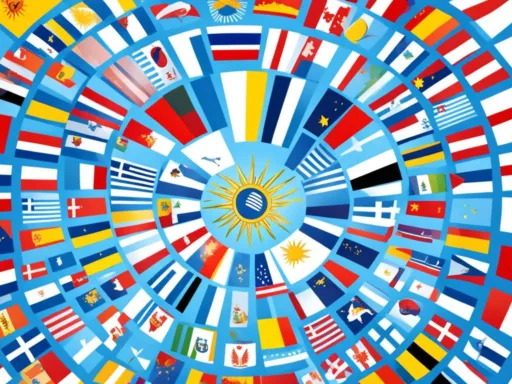Gaze upon the vibrant cultural mosaic that is Guatemala, and you’ll discover a nation steeped in linguistic richness. Here, the languages spoken in Guatemala paint a picture of its diverse heritage and the enduring legacy of its indigenous populations. As the Guatemala official language, Spanish forms the communicative backbone of the country, but the echoes of ancient tongues resonate through the highlands and rural areas where Mayan languages thrive.
In this fascinating linguistic journey, we uncover the splendid Guatemala language diversity that boasts not only the Ibero-Romance tongue of Spanish but also a wealth of indigenous dialects that contribute to the pluralistic languages in Guatemala. This interweaving of old-world speech with contemporary cadence defines Guatemala’s unique standing in the global tapestry of languages.
Key Takeaways
- Spanish, deeply rooted from colonial times, stands as the official language of Guatemala.
- Guatemala celebrates an incredible array of indigenous languages, including twenty-six Mayan languages.
- The linguistic tapestry of Guatemala showcases the resilience and richness of its cultural diversity.
- Recognition of minority languages like Xinca and Garifuna highlights the nation’s dedication to preserving its linguistic heritage.
- Understanding the essence of Guatemala’s language diversity provides a window into the country’s complex history and cultural identity.
The Predominance of Spanish in Guatemala
The threads of history and modernity intertwine in the tapestry of the Spanish language in Guatemala. With captivating resonance, Spanish echoes through bustling city streets and stretches over verdant landscapes as the primary medium for daily communication and education. Here, we embark on an exploration of Spanish as Guatemala’s linguistic stalwart, a narrative steeped in colonial heritage and continued suzerainty in the republic’s civic and cultural forums.

A Brief History of Spanish in Guatemala
The colonial conquests of the 16th century saw the advent of Spanish on Guatemalan soil, sowing seeds that would sprout into a robust linguistic presence nationwide. Over the ensuing centuries, Spanish burgeoned, permeating every echelon of society and facilitating the inception of a unique variant—Guatemalan Spanish. Despite the Spanish language’s widespread embrace, Guatemala language statistics show that many indigenous communities maintain their ancestral tongues, with a significant demographic employing Spanish as a second language.
Regional Variations of Spanish in Guatemala
Guatemala’s diverse geography is mirrored in the symphony of its Spanish dialects. The Spanish spoken in Guatemala isn’t monolithic; instead, it’s textured by regional nuances that reflect the nation’s complex topography—from the dynamic idiolects thriving in the urban sprawl of Guatemala City to the tempered cadences resonating in the rural highlands. This linguistic variety enhances the cultural richness of the nation, as depicted in the Guatemala language map.
Spanish Language Influence on Education and Official Affairs
The jurisdiction of Spanish extends well into the realms of education and governance. As mandated by the country’s educational system, Spanish predominantly guides the dissemination of knowledge in classrooms throughout Guatemala, thereby reinforcing its influence on future generations. In the sphere of official affairs, it plays a pivotal role, affixing a common thread of communication in the diverse fabric of Guatemalan society. The entrenchment of Spanish in these crucial sectors is testament to its enduring significance as indicated by Guatemala language statistics.
| Aspect | Description |
|---|---|
| Official Status | Spanish is the official language of Guatemala, used in all government and most societal functions. |
| Spanish Speakers | Approximately 93% of Guatemalans speak Spanish, making it the most widely spoken language in the country. |
| Educational Medium | Spanish is the primary language of instruction in educational institutions across Guatemala. |
| Linguistic Diversity | Despite Spanish’s dominance, Guatemala is home to over 20 indigenous languages alongside various Spanish dialects. |
The Vitality of Mayan Languages in Guatemala
The intricate tapestry of Mayan languages in Guatemala is a testament to a rich cultural past. This array of dialects, deeply rooted in history, carries forward the stories and knowledge of an ancient civilization. Still spoken across the nation, these languages are central to the cultural identity of Guatemala’s indigenous communities and a focal point for efforts in language preservation in Guatemala.
While Spanish dominates the linguistic landscape as the official language, it is the Mayan tongues that add vivid strokes to Guatemala’s cultural canvas, emphasizing the need to foster indigenous languages in Guatemala. Here, we delve into the vibrant life force of these languages, particularly K’iche’, and the initiatives ensuring their survival alongside the national language.

K’iche’: Beyond Being the Second Most Spoken Language
K’iche’, holding the position of the second most spoken language in Guatemala, is more than just a method of communication—it is the lifeline of over a million hearts and minds. With its prevalence in six departments, it showcases an unbroken linguistic tradition that reflects its community’s resilience and is an integral part of Guatemala’s linguistic heritage.
Preserving the Linguistic Heritage through Bilingual Education
In order to preserve this irreplaceable linguistic heritage, Guatemala has invested in bilingual educational programs. These initiatives aim to bridge the gap between indigenous and non-indigenous populations, nurturing a generation that is fluent in both Spanish and their ancestral Mayan tongues. It is a crucial step towards safeguarding linguistic diversity and ensuring the voices of all cultural facets in Guatemala are heard and valued.
Mayan Languages and Their Regional Dispersion
Mayan languages are not a monolith but rather a collection of distinct voices, each thriving in specific regions of Guatemala. These languages form a patchwork of communication, synonymous with the rich topography of the nation. From the mist-covered highlands where Kaqchikel is spoken to the tropical Petén where Itza’ echoes, each language is a fiber in the social fabric of the country. The Guatemalan government’s intercultural language exchange programs are key to maintaining the vibrancy and vitality of these linguistic treasures.
- K’iche’: Spoken by over a million, primarily in the central highlands
- Q’eqchi’: The voice of Alta Verapaz and El Quiché regions
- Kaqchikel: Deeply connected with the central and southeastern highlands
- Mam: Resonating through the departments of San Marcos and Huehuetenango
The devotion to language preservation in Guatemala, as seen in education and local community support, is the defining element in the survival of these ancient tongues. It’s through initiatives such as the Tz’utujil language app created by Manuel, a Mil Milagros Administrative Assistant, that the younger generation finds new incentives to embrace their indigenous linguistic roots.
Through the melding of education and technology, the horizons of Mayan languages in Guatemala continue to expand, offering a promise for their endurance and a tribute to the country’s ancestral legacy. With each spoken word and each new learner, the narrative of the Mayan people gains another page, preserving their stories and wisdom for generations to come.
Languages Spoken in Guatemala: Diversity Beyond the Official Language
The remarkable Guatemala language diversity extends well beyond the official language of Spanish. In this multifaceted linguistic environment, the myriad of voices comprising the indigenous languages of Guatemala narrate stories of cultural tenacity and heritage. These tongues, which include over 22 distinct Mayan dialects, as well as the Garífuna and Xinca languages, are vivid testimony to the resilience of Guatemala’s various indigenous groups and their commitment to preserving ancestral linguistic customs.
Guatemala’s linguistic tapestry is further enriched by minority languages that have made their way to the nation’s shores, languages such as Plautdietsch, Korean, and Arabic. This confluence of native and foreign tongues not only adds a cosmopolitan dimension to Guatemala’s cultural identity but also demonstrates the country’s role as a crossroads of global cultures and ideas.

The impact of the indigenous languages of Guatemala is not confined to mere communication; these languages embody the living heritage of their respective communities. For example, the Tz’utujil language, spoken in the highland regions, symbolizes the enduring spirit of its native speakers. Similarly, the Ch’orti’ language is intrinsic to the cultural fabric of the eastern regions, whereas the Garifuna language harbors the legacy of Afro-Caribbean communities along the coastal areas.
With such a vibrant spectrum of languages spoken in Guatemala, efforts to nurture and pass these treasures to future generations play a crucial role in cultural conservation. This dedication to linguistic heritage is manifest in various educational initiatives and community outreach programs aimed at promoting multilingual fluency and recognition of the country’s wide array of endemic and foreign languages spoken in Guatemala.
| Language | Region | Approximate Number of Speakers |
|---|---|---|
| K’iche’ | Central Highlands | 1,000,000 |
| Q’eqchi’ | Alta Verapaz, El Quiché | 555,461 |
| Kaqchikel | Central and Southeastern Highlands | 500,000 |
| Mam | San Marcos, Huehuetenango | 480,000 |
| Garifuna | Caribbean Coast | 5,860 |
| Xinca | Santa Rosa, Jutiapa | Approx. 200 |
To grasp the full breadth of Guatemala’s language diversity is to appreciate the nation’s colorful past and its dynamic present. As these languages continue to be spoken and treasured by their communities, they enrich not only Guatemala but also contribute to the world’s cultural mosaic, ensuring that the voices of Guatemala’s people remain robust and resonant through time.
Guatemala’s Language Map and Statistics
The Guatemala language map stands as a testament to the nation’s rich history and ethnolinguistic diversity. Delve into the visual representation of languages in Guatemala, and you will find a dynamic interlace of linguistic threads, each firmly rooted in the country’s social and geographical fabric. Let’s explore the distribution of languages that shape the collective voice of this vibrant nation.

Analysis of Language Distributions across Regions
The linguistic contours of Guatemala reveal the predominance of Spanish as the official and widely spoken language, serving as the linchpin for national communication. Yet, it is the dispersion of the Mayan languages, such as K’iche’, Q’eqchi’, and Kaqchikel, that eloquently narrates the story of Guatemala’s indigenous soul. Illuminated by the Guatemala language map, each linguistic community marks its territory, defining the cultural and physical landscape of their region.
Demographic Insights and Linguistic Proliferation
Delving into Guatemala language statistics, a captivating demographic mosaic unfolds. Spanish blankets the nation, but indigenous tongues pulse through the heartland, echoing their ancestral legacy. K’iche’, for instance, resonates with over a million voices, primarily in the central highlands. The northern and eastern quarters hum to the melodies of Q’eqchi’, while the tones of Kaqchikel filter through the central and southeastern highlands.
Yet, beyond these widely spoken dialects, linguistic stalwarts like Xinca fight for survival, with a mere handful of custodians keeping the language alive. Along the Caribbean coast, the Arawakan Garifuna serves as a cultural beacon, with every utterance encapsulating a unique heritage spanning continents and epochs. This intricate linguistic framework is not merely the sum of its parts but a living, thriving organism—evolving, growing, and asserting its place within the nation and beyond.
| Language | Region | Speakers |
|---|---|---|
| Spanish | Nationwide | 9,481,907 |
| K’iche’ | Central Highlands | 1,000,000 |
| Q’eqchi’ | Alta Verapaz, El Quiché | 555,461 |
| Kaqchikel | Central and Southeastern Highlands | 500,000 |
| Xinca | Santa Rosa, Jutiapa | Approx. 200 |
| Garifuna | Caribbean Coast | 5,860 |
Conclusion
The intricate blend of languages spoken in Guatemala tells a story of a nation’s enduring spirit and the richness of its cultural tapestry. Tracing the footsteps of its indigenous roots against the backdrop of colonial influence reveals a complex yet harmonious linguistic landscape. With the widespread use of Spanish providing a consistent thread of communication, Guatemala’s language diversity also showcases a proud mosaic of indigenous tongues, each one bearing the soul and resilience of its people.
Preserving heritage in Guatemala serves as a cornerstone for maintaining the vibrancy of these historic languages. By prioritizing bilingual education and leveraging technological innovations such as language apps, Guatemala is actively finding ways to nourish and promote its myriad of dialects. This not only strengthens cultural identity but also equips future generations with the key to unlock their rich ancestral wisdom.
In the realm of globalization’s relentless tide, the commitment to preserving linguistic diversity is more vital than ever. Guatemala exemplifies a nation that respects its past while adapting to an ever-evolving global context. As the country forges ahead, it does so with a firm hold on its heritage, ensuring that the languages spoken in Guatemala—spanning from Spanish to K’iche’, Q’eqchi’, and even the endangered Xinca—continue to resonate and embody the nation’s diverse human tapestry.
FAQ
What is the official language of Guatemala?
The official language of Guatemala is Spanish, which is used in government affairs and mainstream education.
Are there other languages spoken in Guatemala besides Spanish?
Yes, aside from Spanish, Guatemala is home to a myriad of indigenous languages including twenty-two Mayan languages, Garífuna, and Xinca.
How does the Spanish language in Guatemala differ from other countries?
Guatemala has its own regional variations of Spanish, which include unique local idioms, expressions, and vocabulary influenced by indigenous languages and the country’s geography.
Is Spanish the only language used in education in Guatemala?
While Spanish is the primary language of instruction, there are bilingual education programs that integrate various indigenous languages, especially Mayan, alongside Spanish.
What efforts are being made to preserve indigenous languages in Guatemala?
There are several initiatives such as bilingual education, intercultural language exchange programs, and language apps designed to foster learning and preserve the linguistic heritage of indigenous languages.
Can you tell me more about K’iche’ and its significance in Guatemala?
K’iche’ is the second most spoken language in Guatemala with about 1 million speakers. It holds cultural and historical significance in several departments and is part of education and literary works, reflecting its vitality in Guatemalan society.
Are there any non-indigenous foreign languages spoken in Guatemala?
Yes, while indigenous languages are predominant in rural areas, there’s also a presence of minority languages such as Plautdietsch (spoken by Mennonite communities), Korean, and Arabic, revealing Guatemala’s linguistic diversity.
How does Guatemala’s language map reflect the country’s linguistic diversity?
The language map of Guatemala visually represents the distribution of the various languages spoken across the country, highlighting the prevalence and regional dominance of indigenous languages alongside Spanish.
What’s the situation of linguistic diversity among the population of Guatemala?
Linguistic diversity in Guatemala is notable, with vast ranges in the number of speakers for each language. While some indigenous languages have thousands of speakers, others like Xinca are endangered with very few remaining speakers.
What challenges do Guatemala’s languages face in modern society?
Challenges include the dominance of Spanish as a global language, rural to urban migration affecting transmission of indigenous languages, and the need for more resources and support for linguistic preservation initiatives.






